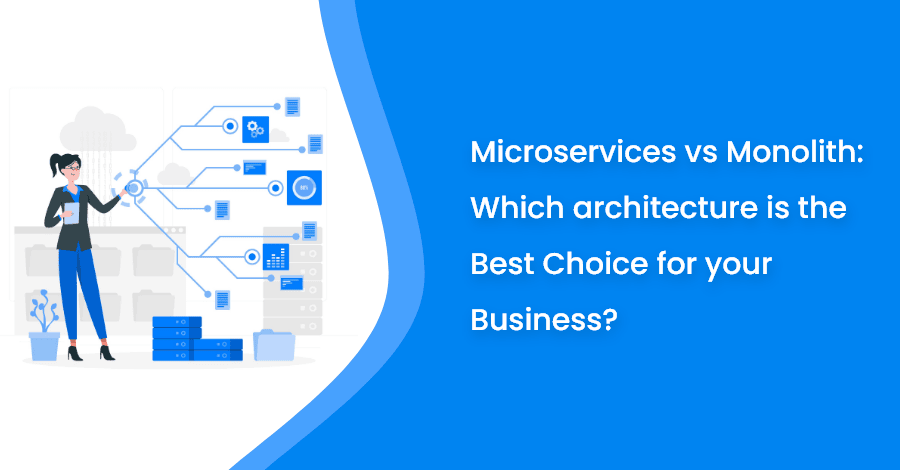
17 Feb Microservices vs Monolithic: Ideal Architecture for Business
17 February 2023

Microservices vs Monolithic are two popular software architecture patterns that have gained significant traction in recent years. Both approaches have their own pros and cons, and the choice between them depends on various factors, including the nature and size of the business, the complexity of the system, and the technical capabilities of the team. In this article, we’ll dive into Microservices vs Monolithic architecture and explore the advantages and disadvantages of each, helping you determine which approach is the best choice for your business.
Monolithic Architecture
A Monolithic architecture refers to a single, tightly coupled software application that encompasses all the features and functions of a system. In other words, it’s a large, monolithic application that runs as a single unit. This approach is simple and straightforward, making it easy to develop, test, and deploy. Monolithic are typically built using a single programming language, making it easier to maintain and manage the codebase.
Microservices Architecture
Microservices architecture refers to a software development approach where a system is built as a collection of small, independent services that work together to provide a complete solution. Each Microservice is responsible for a specific function, such as authentication, user management, or payment processing. Microservices can be developed and deployed independently, making it easier to scale, maintain, and update the system.
Pros and Cons of Microservices vs Monolithic architecture
Advantages of Microservices Architecture
Scalability: Microservices architecture makes it easier to scale the system, as each Microservice can be scaled independently, without affecting the other components of the system. This allows organizations to accommodate increased traffic and processing demands without having to make major changes to the system as a whole.
Flexibility: Also allows for greater flexibility, as each Microservice can be updated and modified independently, without affecting the other components of the system. This makes it easier to implement new features and make changes to the system without having to redeploy the entire application.
Improved Resilience: With Microservices, if a single component fails, the rest of the system can continue to operate normally, improving overall system resilience. This makes it less likely for the entire system to be affected by a single point of failure.
Better Resource Utilization: Microservices can make better use of resources, as each service can be deployed on the most appropriate infrastructure, depending on its requirements. This can result in improved performance and faster execution times.
Technology Independence: Microservices architecture allows for technology independence, as each service can be developed using the most appropriate technology for the task at hand. This makes it easier to choose the best tools for the job and allows for flexible and efficient development.
Improved Deployment: It allows for the faster and more efficient deployment, as each service can be deployed and tested independently. This makes it easier to roll out new features and make changes to the system without affecting the entire application.
Easy Maintenance: This architecture makes it easier to maintain the system, as each service can be updated and modified independently. This makes it easier to address bugs and improve the quality of the code without having to make changes to the entire system.
Advantages of Monolithic Architecture
Simplicity: Monolithic architecture is simple and straightforward, making it easier for developers to understand and implement. The architecture is easy to design, implement, and maintain due to its single, tightly coupled codebase.
Reduced Complexity: With all the features and functions of the system integrated into a single application, there is less complexity involved in the development, testing, and deployment process. This makes it easier to manage the codebase and ensures consistency throughout the system.
Better Resource Utilization: Monolithic applications can make better use of resources such as memory and CPU, as they run as a single unit. This can result in improved performance and faster execution times.
Easier to Test: With all the features and functions of the system integrated into a single application, testing is more straightforward and can be done more efficiently. This makes it easier to identify and fix bugs and improve the overall quality of the code.
Cost Effective: Monolithic architecture is often less expensive to develop, as it requires fewer resources and less infrastructure. It also requires fewer tools, making it easier to manage the development and deployment process.
Improved Collaboration: It allows for improved collaboration between team members, as everyone is working on the same codebase. This makes it easier to share knowledge and expertise, leading to more efficient and effective development.
Conclusion
Comparing microservices architecture vs monolithic architecture, the former is a popular trend with many entrepreneurs claiming that their app is built with it. However, one should not be swayed by its popularity and instead evaluate its value based on metrics such as performance monitoring. For established businesses, microservices can bring benefits such as continuous deployment, team-based development, and the ability to adapt to new technologies. On the other hand, for startups, jumping into microservices may have a negative impact on software project success if not implemented properly. It’s advisable for startups to seek help from a reputable app development company, such as Star Knowledge, to ensure a smooth development process.
Our Related Posts
Reasons Why Team Augmentation is Important for Your Business
If you’re like most businesses these days, you’re always looking for ways to do more with less.….
Staff augmentation: A Successful Model for Expanding Your Team
Due to a shortage of technical talent on the team, businesses frequently struggle to accomplish project….
Why Agile Methodology Is Great for Outsourced Software Development
While most businesses are permanently shifting to remote working habits, outsourcing remains the best choice….









No Comments